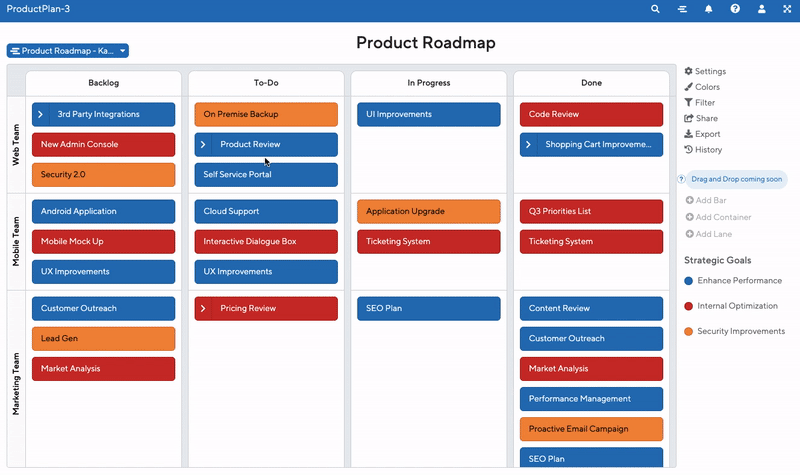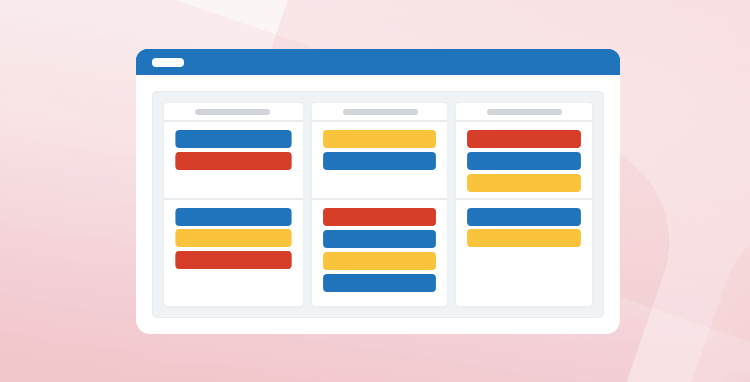What is a Kanban Board?
Kanban boards serve a very simple purpose. These workflow visualization tools are the ultimate living status report. Stakeholders can see which projects are in progress with a quick glimpse, what’s done, and what’s next in the queue.
Although it may seem like this is a better-suited tool for project management, there’s plenty of overlaps with product management needs. Providing universal and straightforward visibility into where things are can be extremely helpful for any shape or size of product teams. They eliminate constant requests for status updates and offer a real-time view of what stage every initiative is in currently.
The sequential nature of Kanban boards also serves as an educational tool. They ensure everyone knows each stage and gate a project must pass through before it finally reaches end-users.
Their visual representation of items communicates organizational priorities, as their position in each column indicates their relative importance. Plus, compared to a timeline-based view of things, Kanban boards can help shift the focus from dates and deadlines to just getting things done as soon as possible.
Kanban boards also facilitate maximum resource utilization. Kanban board eliminates all confusion, telling teams which is the next task they should tackle.
How to Create a Kanban Board in Five Steps?
PMs can set up Kanban boards in seconds. But spending a little time upfront thinking about your board’s purpose makes it far more useful.

1. Pick a tool
An IRL Kanban board is pretty simple to create. Mostly you need a big wall or whiteboard that people will leave alone for the duration, plus a whole lot of sticky notes or index cards and tape.
It allows for impromptu Kanban-ing sessions for brainstorming, prioritization, and strategy planning, and all the color-coding and rearranging can be pretty fun and interactive. However, uninterrupted wall space is typically in short supply in most meeting rooms, and putting it up in someone’s office will limit its visibility and utility after that initial session.
More importantly, a physical Kanban board only works for people in the same location. With distributed teams and remote work more common than ever, a digital solution is far more practical for ongoing usage and reference.
Luckily, Kanban boards are such popular project management tools that everyone is spoiled for choosing products and apps that feature Kanban capabilities.
- Trello is a popular choice and includes “PowerUps” that integrate with other tools commonly found in product development stacks, including Slack, Google Calendar, and InVision.
- GitHub has a built-in “project board” feature that supports Kanban board creation from within the application, simplifying consolidated project management efforts.
- Kanban-style product roadmaps can also be created within ProductPlan, offering an alternative to timeline-based formats.
2. Define the columns
Kanban boards are fluid by definition. However, one attribute that shouldn’t change too often is the columns that define the different stages of the process. Take some care to define all the required columns early on, so everyone knows what they mean by the criteria for moving an item to the next column on the board.
These columns should mirror the organization’s workflow (or perhaps an idealized version of it). To-Do, Doing, and Done, are pretty common starting points, but flesh this out for more granularity and inclusiveness.
Additions could include Next, Up Next, Blocked, Canceled, and the like. Of course, too many columns are also problematic and overly complex. Shoot for columns where items are likely to linger for a while and mean something to colleagues.
To cover all the bases, defining this workflow and its corresponding activities should be a group activity. There may be some less obvious ones that are important differentiators for other departments, or worthy sub-columns delineating the internal stages for a particular process in the workflow.
For example, “Doing” may have sub-steps that must be called out, such as Being Designed, Being Built, Being Tested. What’s most important is that every column is meaningful for all stakeholders interacting and leveraging the Kanban board for their work and planning purposes.
It is also the appropriate time to consider if the Kanban board would benefit from rows or swimlanes. It allows the contents to be divided up vertically based on criteria such as themes, product lines, or product components (such as “user experience” and “architecture”).
3. Populate the board
With a skeleton framework defined, it’s time to add some meat to the bones. In this case, we add Kanban cards. Each card should include a brief description of the item in question, along with its status, due dates (if applicable), or its owner.
Add and place Kanban cards on the board based on their priority and timeline for various tasks or projects. The most critical items should be at the top of the column, with the rest flowing down in descending order of importance. It inherently conveys priorities and eliminates confusion about what should get priority.
Each card should also only represent a discrete item versus a massive multi-stage initiative. If the scope of a card seems too broad, consider breaking it down into multiple cards.
4. Set expectations
With the initial Kanban board set, it’s time to lay down the rules of engagement. If anyone has the ability and authority to change things willy nilly, the board will quickly lose its value and could even damage product management’s credibility. To avoid this, the ability to rearrange, add, or remove items should be limited to a few people (or even a sole owner). If others want a change, they can bring it to one of those with edit rights.
More importantly, clearly communicate and discuss the purpose and goals of the Kanban board. If people don’t recognize its value, they’re less likely to rely on it, and its benefits will vastly diminish.
Refer to the Kanban board regularly in various forums. These continual reminders can reinforce their benefits and utility versus just another pointless process to follow.
5. Establish a feedback-friendly atmosphere
Kanban boards are only as good as the advantages they offer. As things change, products evolve, and staff turns over, what originally fit well for the organization and process may no longer meet those needs.
As stakeholders complain or make suggestions, be open to this input and adjust the board to serve the organization better. Whether it’s missing columns or is too specific, these tweaks are simple to make with any Kanban board tool and increase the exponential usage and benefits of the board.

Beyond the Board
Kanban boards have more to offer than just managing projects and priorities. They can serve as product roadmaps as well.
This format frees product management up from committing to any dates while still sharing the product vision and illuminating how different initiatives will allow the product to meet its goals and objectives. While they’re not always a fit, product managers should consider the pros and cons of Kanban-style product roadmaps versus those based on a timeline.
Ready to start Kanban-ing in your organization? Download our checklists to streamline the process and make sure you don’t miss anything.




